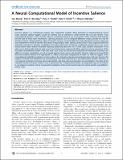A Neural Computational Model of Incentive Salience
Author(s)
Zhang, Jun; Berridge, Kent C.; Tindell, Amy J.; Smith, Kyle S.; Aldridge, J. Wayne
DownloadZhang-2009-A Neural Computational Model of Incentive Salience.pdf (556.1Kb)
PUBLISHER_CC
Publisher with Creative Commons License
Creative Commons Attribution
Terms of use
Metadata
Show full item recordAbstract
Incentive salience is a motivational property with ‘magnet-like’ qualities. When attributed to reward-predicting stimuli (cues), incentive salience triggers a pulse of ‘wanting’ and an individual is pulled toward the cues and reward. A key computational question is how incentive salience is generated during a cue re-encounter, which combines both learning and the state of limbic brain mechanisms. Learning processes, such as temporal-difference models, provide one way for stimuli to acquire cached predictive values of rewards. However, empirical data show that subsequent incentive values are also modulated on the fly by dynamic fluctuation in physiological states, altering cached values in ways requiring additional motivation mechanisms. Dynamic modulation of incentive salience for a Pavlovian conditioned stimulus (CS or cue) occurs during certain states, without necessarily requiring (re)learning about the cue. In some cases, dynamic modulation of cue value occurs during states that are quite novel, never having been experienced before, and even prior to experience of the associated unconditioned reward in the new state. Such cases can include novel drug-induced mesolimbic activation and addictive incentive-sensitization, as well as natural appetite states such as salt appetite. Dynamic enhancement specifically raises the incentive salience of an appropriate CS, without necessarily changing that of other CSs. Here we suggest a new computational model that modulates incentive salience by integrating changing physiological states with prior learning. We support the model with behavioral and neurobiological data from empirical tests that demonstrate dynamic elevations in cue-triggered motivation (involving natural salt appetite, and drug-induced intoxication and sensitization). Our data call for a dynamic model of incentive salience, such as presented here. Computational models can adequately capture fluctuations in cue-triggered ‘wanting’ only by incorporating modulation of previously learned values by natural appetite and addiction-related states.
Date issued
2009-05Department
McGovern Institute for Brain Research at MITJournal
PLoS Computational Biology
Publisher
Public Library of Science
Citation
Zhang, Jun et al. “A Neural Computational Model of Incentive Salience.” PLoS Comput Biol 5.7 (2009): e1000437.
Version: Final published version
ISSN
1553-734X
1553-7358